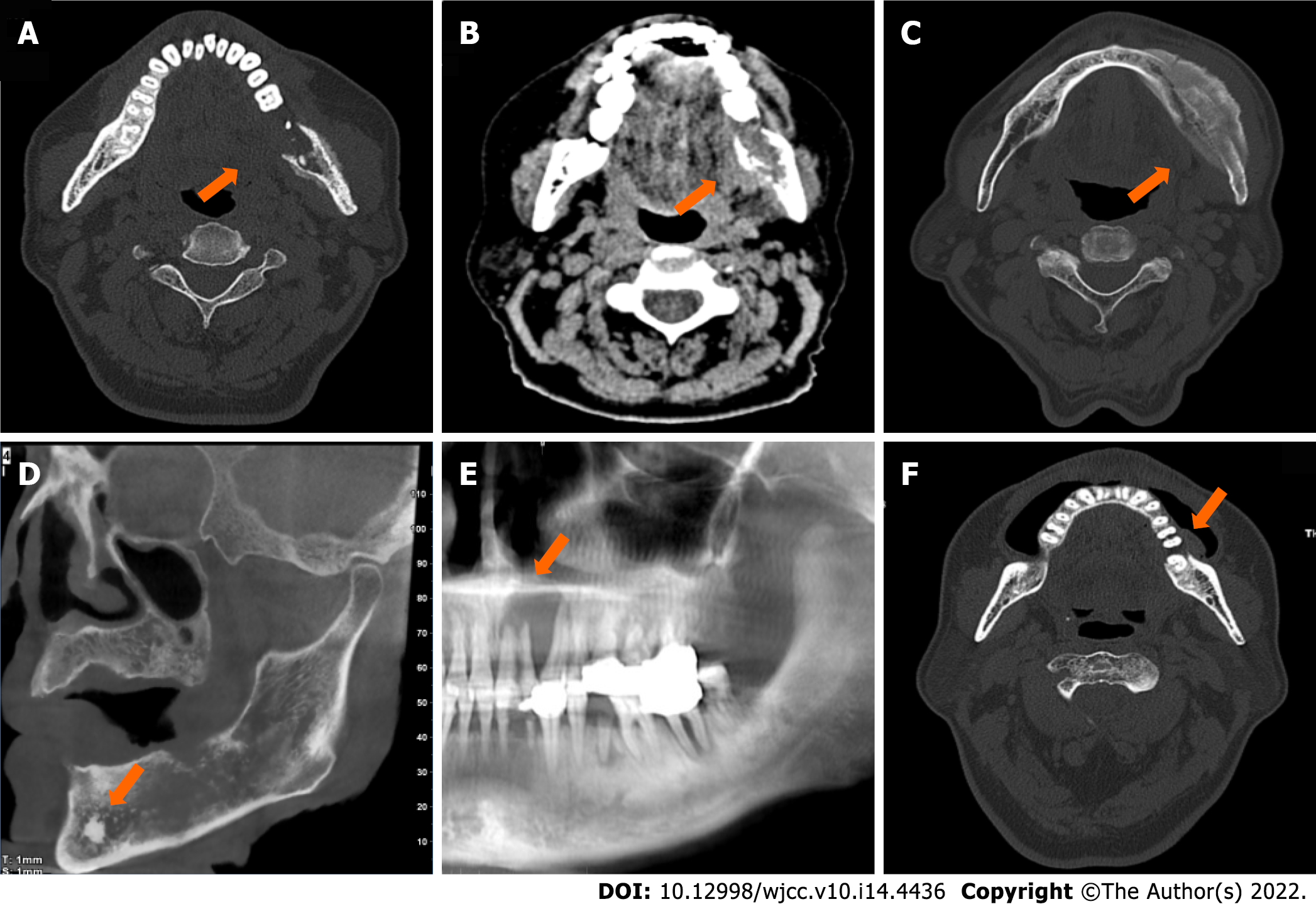Copyright
©The Author(s) 2022.
World J Clin Cases. May 16, 2022; 10(14): 4436-4445
Published online May 16, 2022. doi: 10.12998/wjcc.v10.i14.4436
Published online May 16, 2022. doi: 10.12998/wjcc.v10.i14.4436
Figure 1 Five types of metastatic adenocarcinoma of the jaw.
A: Osteolytic type. Axial spiral-computed tomography (SCT) with bone window showed decreased radiodensity of the lesion (arrow) with a permeative margin. The multi-layered periosteal reaction was observed on the buccal and lingual sides of the left mandibular ramus; B: Osteolytic type. Axial SCT with soft-tissue window showed a confined soft tissue mass (arrow) at the lingual side of the left mandibular ramus; C: Osteoblastic type. Axial SCT with bone window showed increased radiodensity of the lesion (arrow) with a sclerotic margin; D: Mixed type. Oblique sagittal cone beam CT showed both osteolytic and osteoblastic lesions (arrow) with a moth-eaten margin, and an “ivory” pattern of osseous tumour matrix was centred in the left mandibular at the location of mental foramen; E: Cystic type. Partial panorama reconstruction radiograph showed homogeneous radiodensity of the lesion (arrow) in the anterior part of the maxilla with a geographic margin. Teeth displacement and root resorption were observed; F: Alveolar bone resorption type. Axial SCT with bone window showed bone destruction was confined to the alveolar bone with a geographic margin. A soft tissue component was at the buccal side.
Figure 2 Three cases of the cystic type of metastatic adenocarcinoma of the jaw.
A: Coronal cone beam computed tomography (CBCT), is the same case as in Figure 1E; B: Oblique sagittal spiral-CT; C: CBCT revealed homogeneous radiodensity of the lesions (arrow) with geographic margins.
Figure 3 Radiological classifications and lesion margins in 14 patients with metastatic adenocarcinoma of the jaw.
Figure 4 A patient with metastatic adenocarcinoma of the jaw of primary liver cancer.
A: Intraoral image before tooth extraction showed swelling of the gingival surrounding the wisdom tooth (arrow); B: Panorama radiograph before tooth extraction showed periodontal bone loss around the involved tooth (arrow); C: At a two-month follow-up visit, the extraction wound did not heal completely; D: Four months after tooth extraction, oblique sagittal cone beam computed tomography (CT) showed lesion (arrow) turned bulky with a permeative margin. The wall of the inferior alveolar nerve was invisible; E: Immunohistochemistry for the expression of CK8/18 revealed uniform positivity in the cytoplasm of tumour cells (Magnification: 100 ×); F: Immunohistochemistry for the expression of Ki-67 revealed scattered positivity in more than 65% of the tumour cells (Magnification: 100 ×); G: Positron emission tomography-CT scans showed asymptomatic hepatocellular carcinoma as the primary site and multiple metastases mainly involving the right mandible, spine, and bilateral pelvic bone (arrows).
- Citation: Shan S, Liu S, Yang ZY, Wang TM, Lin ZT, Feng YL, Pakezhati S, Huang XF, Zhang L, Sun GW. Oral and maxillofacial pain as the first sign of metastasis of an occult primary tumour: A fifteen-year retrospective study. World J Clin Cases 2022; 10(14): 4436-4445
- URL: https://www.wjgnet.com/2307-8960/full/v10/i14/4436.htm
- DOI: https://dx.doi.org/10.12998/wjcc.v10.i14.4436












